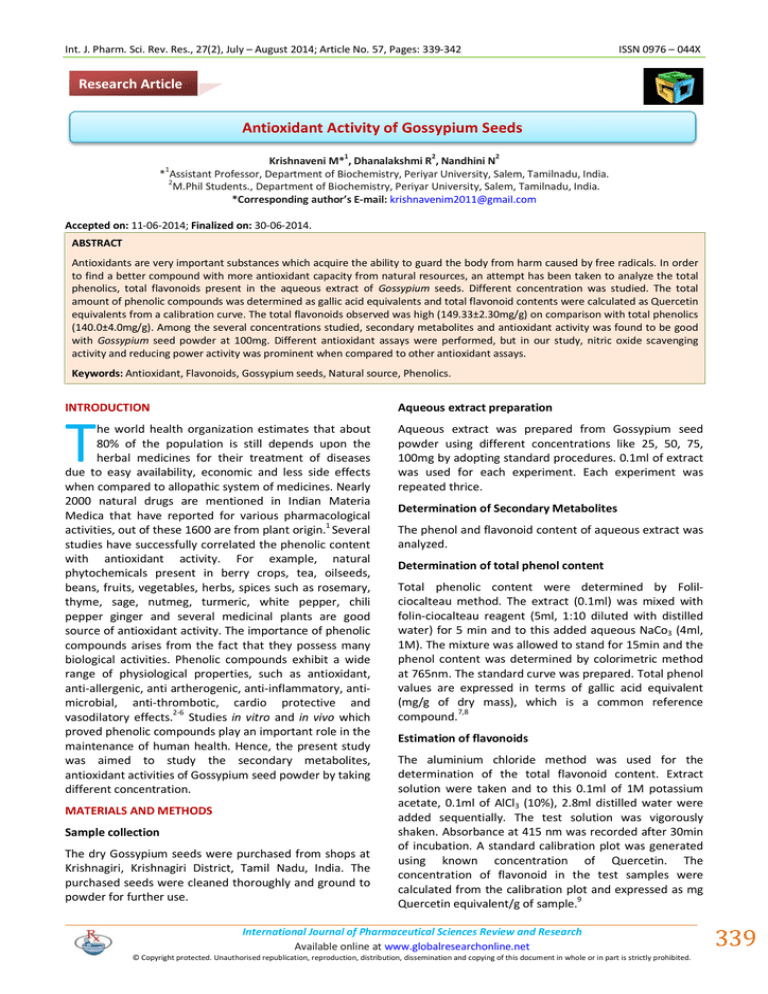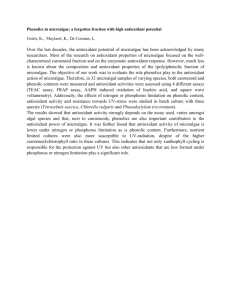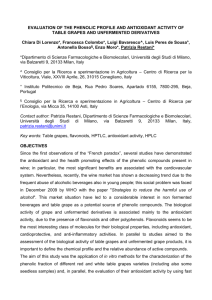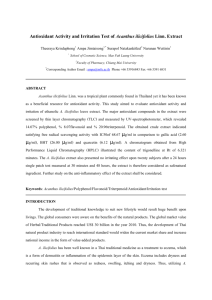Document 13309948
advertisement

Int. J. Pharm. Sci. Rev. Res., 27(2), July – August 2014; Article No. 57, Pages: 339-342 ISSN 0976 – 044X Research Article Antioxidant Activity of Gossypium Seeds 1 2 2 Krishnaveni M* , Dhanalakshmi R , Nandhini N * Assistant Professor, Department of Biochemistry, Periyar University, Salem, Tamilnadu, India. 2 M.Phil Students., Department of Biochemistry, Periyar University, Salem, Tamilnadu, India. *Corresponding author’s E-mail: krishnavenim2011@gmail.com 1 Accepted on: 11-06-2014; Finalized on: 30-06-2014. ABSTRACT Antioxidants are very important substances which acquire the ability to guard the body from harm caused by free radicals. In order to find a better compound with more antioxidant capacity from natural resources, an attempt has been taken to analyze the total phenolics, total flavonoids present in the aqueous extract of Gossypium seeds. Different concentration was studied. The total amount of phenolic compounds was determined as gallic acid equivalents and total flavonoid contents were calculated as Quercetin equivalents from a calibration curve. The total flavonoids observed was high (149.33±2.30mg/g) on comparison with total phenolics (140.0±4.0mg/g). Among the several concentrations studied, secondary metabolites and antioxidant activity was found to be good with Gossypium seed powder at 100mg. Different antioxidant assays were performed, but in our study, nitric oxide scavenging activity and reducing power activity was prominent when compared to other antioxidant assays. Keywords: Antioxidant, Flavonoids, Gossypium seeds, Natural source, Phenolics. INTRODUCTION Aqueous extract preparation T he world health organization estimates that about 80% of the population is still depends upon the herbal medicines for their treatment of diseases due to easy availability, economic and less side effects when compared to allopathic system of medicines. Nearly 2000 natural drugs are mentioned in Indian Materia Medica that have reported for various pharmacological activities, out of these 1600 are from plant origin.1 Several studies have successfully correlated the phenolic content with antioxidant activity. For example, natural phytochemicals present in berry crops, tea, oilseeds, beans, fruits, vegetables, herbs, spices such as rosemary, thyme, sage, nutmeg, turmeric, white pepper, chili pepper ginger and several medicinal plants are good source of antioxidant activity. The importance of phenolic compounds arises from the fact that they possess many biological activities. Phenolic compounds exhibit a wide range of physiological properties, such as antioxidant, anti-allergenic, anti artherogenic, anti-inflammatory, antimicrobial, anti-thrombotic, cardio protective and 2-6 vasodilatory effects. Studies in vitro and in vivo which proved phenolic compounds play an important role in the maintenance of human health. Hence, the present study was aimed to study the secondary metabolites, antioxidant activities of Gossypium seed powder by taking different concentration. MATERIALS AND METHODS Sample collection The dry Gossypium seeds were purchased from shops at Krishnagiri, Krishnagiri District, Tamil Nadu, India. The purchased seeds were cleaned thoroughly and ground to powder for further use. Aqueous extract was prepared from Gossypium seed powder using different concentrations like 25, 50, 75, 100mg by adopting standard procedures. 0.1ml of extract was used for each experiment. Each experiment was repeated thrice. Determination of Secondary Metabolites The phenol and flavonoid content of aqueous extract was analyzed. Determination of total phenol content Total phenolic content were determined by Folilciocalteau method. The extract (0.1ml) was mixed with folin-ciocalteau reagent (5ml, 1:10 diluted with distilled water) for 5 min and to this added aqueous NaCo3 (4ml, 1M). The mixture was allowed to stand for 15min and the phenol content was determined by colorimetric method at 765nm. The standard curve was prepared. Total phenol values are expressed in terms of gallic acid equivalent (mg/g of dry mass), which is a common reference compound.7,8 Estimation of flavonoids The aluminium chloride method was used for the determination of the total flavonoid content. Extract solution were taken and to this 0.1ml of 1M potassium acetate, 0.1ml of AlCl3 (10%), 2.8ml distilled water were added sequentially. The test solution was vigorously shaken. Absorbance at 415 nm was recorded after 30min of incubation. A standard calibration plot was generated using known concentration of Quercetin. The concentration of flavonoid in the test samples were calculated from the calibration plot and expressed as mg Quercetin equivalent/g of sample.9 International Journal of Pharmaceutical Sciences Review and Research Available online at www.globalresearchonline.net © Copyright protected. Unauthorised republication, reproduction, distribution, dissemination and copying of this document in whole or in part is strictly prohibited. 339 © Copyright pro Int. J. Pharm. Sci. Rev. Res., 27(2), July – August 2014; Article No. 57, Pages: 339-342 Determination of Antioxidant Activities Nitric oxide scavenging assay, Reducing power assay, Total antioxidant assay, Metal chelating activities were performed. Reducing power assay Aqueous extract was mixed with phosphate buffer (2.5ml, 0.2M, PH 6.6) and potassium ferricyanide (2.5ml, 1%). The mixture was incubated at 50°C for 20min. 1.0 ml of Trichloro acetic acid (10%) was added to stop the reaction, which was then centrifuged at 3000rpm for 10min. The upper layer of solution (1.5ml) was mixed with distilled water (1.5ml) and FeCl3 (0.1ml, 0.1%) after mixing, the contents were incubated for 10min and the absorbance was measured at 700nm. Increased absorbance of the reaction mixture indicated increased reducing power. Ascorbic acid was used as a positive control.10 Total antioxidant capacity ISSN 0976 – 044X used for error correction because of unequal color of sample solution.13 For all estimations, readings were taken using UV- Visible spectrophotometer- Shimadzu, Japan make. Model UV 1800. Standard graph were plotted for all experiments using their respective standards and samples were plotted against standard by taking concentration in X axis and OD in Y axis. Statistical Tool Each experiment was carried out in triplicate and the results are given as the mean ± standard deviation. The Mean and Standard deviation (S) was calculated by using the following formula: Mean = Sum of x values / n (Number of values), = ∑( ) . RESULTS AND DISCUSSION Secondary Metabolites Total Phenolics Total antioxidant capacity by phosphomolybdenum method assay is based on the reduction of Mo (V1) to Mo (V) by the sample analyte and subsequent formation of green phosphate/Mo (V) complex at acidic pH by adding 4ml reagent solution containing 0.6M Sulphuric acid, 28mM Sodium phosphate, 4mM Ammonium molybdate. The tubes were incubated in water bath at 95°C for 90 minutes. After the samples had been cooled to RT, the absorbance of mixture was measured at 695nm against blank. The phosphomolybdenum method is quantitative. Since, the total antioxidant activity is expressed as the number of equivalents of ascorbic acid.11 Nitric oxide scavenging activity This procedure is based on the principle that, sodium nitroprusside in aqueous solution, at physiological pH spontaneously generates nitric oxide which interacts with oxygen to produce nitrite ions that can be estimated using Griess reagent. Scavengers of nitric oxide compete with oxygen, leading to reduced production of nitrite ions. For the experiment, sodium nitroprusside (10mM), in phosphate buffered saline was mixed with extract and incubated at room temperature for 150min. After the incubation period, 0.5ml of griess reagent was added. The absorbance of the chromophore formed was read at 546nm. Ascorbic acid was used as a positive control. 12 Figure 1 illustrates the results of total phenolics present in aqueous extract of Gossypium seed powder. The total phenolics observed was 140.0 ± 4.0mg/g using aqueous extract of 100mg Gossypium seed powder, it was 47.33 ± 3.05mg/g when studied with 75mg, While, it was 22.63 ± 1.35mg/g with 50mg Gossypium seed powder, whereas, it was 30.33 ± 1.52mg/g using 25mg Gossypium seed powder. The therapeutic effects, antioxidant activity derived from plants have been attributed to the presence of phenolic compounds such as flavonoids, phenolic acid, proanthocyanidins, diterpenes and tannins14 by inactivating lipid free radicals or by preventing the decomposition of hydroperoxides into free radicals.15 This makes the diverse group of phenolic compounds an interesting target in the search for beneficial phytochemicals.16 Metal chelating activity Add extract (0.1ml) to a solution of 2mM FeCl2 (0.05ml). The reaction was initiated by the addition of 5mM Ferrozine (160µl), the mixture was shaken vigorously and left standing at room temperature for 10min. Absorbance of the solution was then measured spectrophotometrically at 562nm. Standard curve was plotted using ascorbic acid. Distilled water (1.6ml) instead of sample solution was used as a control. Distilled water (160µl) instead of ferrozine was used as a blank, which is Values are Mean± SD for Three experiments Figure 1: Total phenolics in aqueous extract of Gossypium seed powder Total flavonoids Figure 2 depicts the results of total flavonoids. Total flavonoids observed was 149.33 ± 2.30mg/g when studied in aqueous extract of 100mg Gossypium seed powder, at International Journal of Pharmaceutical Sciences Review and Research Available online at www.globalresearchonline.net © Copyright protected. Unauthorised republication, reproduction, distribution, dissemination and copying of this document in whole or in part is strictly prohibited. 340 © Copyright pro Int. J. Pharm. Sci. Rev. Res., 27(2), July – August 2014; Article No. 57, Pages: 339-342 75mg concentration it was found to be 67.33 ± 1.15mg/g, it was 43.53 ± 2.04mg/g at 50mg and at 25mg it was found to be 35.33 ± 1.52mg/g. Flavonoids are economically useful class of water soluble phenolic glycosides which impart color to flowers, fruits of higher plants and play vital role in defense against pathogens, predators and contribute to physiological functions such as seed maturation and dormancy.17 Flavonoids show remarkable antioxidant properties and have many significant biological effects such as anti-allergic, antiinflammatory, anti-spasmolytic, anti-microbial activity.18 ISSN 0976 – 044X concentration of Gossypium seed powder aqueous extract and its observations are shown in Figure 6. The metal chelating ability was found to be 85.33 ± 5.77mg/g, 29.66 ± 1.15mg/g, 15.30 ± 2.0mg/g, 5.83 ± 0.57mg/g at 100, 75, 50, 25mg Gossypium seed powder. The transition metal ion, Fe2+ possesses the ability to move single electrons by virtue of which it can allow the formation and propagation of many radical reactions, even starting with relatively non-reactive radicals.19 Values are Mean± SD for Three experiments Values are Mean± SD for Three experiments Figure 3: Reducing power activity in aqueous extract of Gossypium seed powder Figure 2: Total flavonoids in aqueous extract of Gossypium seed powder Antioxidant Activities Various methods were used to study the antioxidant activities. Figure 3 shows the results of reducing power assay. Reducing power activity was found to be 142.66 ± 2.30, 90.66 ± 1.15, 75.06 ± 3.32, 28.0 ± 2.0mg/g when studied using aqueous extract of 100, 75, 50, 25mg Gossypium seed powder. The activity was found to be high at 100mg Gossypium seed powder aqueous extract. In the reducing power assay, the presence of antioxidants in the samples would result in the reducing of Fe3+ to Fe2+ by donating an electron. Electron transfer occurs in this assay depends upon the structure of the antioxidant.12 Values are Mean± SD for Three experiments Figure 4: Total antioxidant activity in aqueous extract of Gossypium seed powder Total antioxidant activity measured using phophomolybdenum assay is shown in Figure 4. The phosphomolybdenum method usually detects antioxidants such as ascorbic acid, phenolics, tocopherols and carotenoids. Using 100mg Gossipium seed powder aqueous extract, the total antioxidant activity was found to be 86.66 ± 2.30mg/g, and it was 48.66 ± 3.05mg/g with 75mg, 50mg concentration showed 15.06 ± 2.04mg/g total antioxidant activity. While, it was 10.66 ± 3.51mg/g, with 25mg Gossypium seed powder. Nitrous oxide activity is illustrated in Figure 5. The observed results showed that it was 214.66 ± 2.30, 122.66 ± 1.15, 45.76 ± 2.04, 19.33 ± 3.51mg/g when studied in aqueous extract containing 100, 75, 50, 25mg of Gossypium seed powder. Values are Mean± SD for Three experiments Figure 5: Nitric oxide scavenging activity in aqueous extract of Gossypium seed powder The results of metal chelating activity are shown in Figure 6. The metal chelating ability was assessed with different International Journal of Pharmaceutical Sciences Review and Research Available online at www.globalresearchonline.net © Copyright protected. Unauthorised republication, reproduction, distribution, dissemination and copying of this document in whole or in part is strictly prohibited. 341 © Copyright pro Int. J. Pharm. Sci. Rev. Res., 27(2), July – August 2014; Article No. 57, Pages: 339-342 ISSN 0976 – 044X “Flavonoids in health and Disease” C A Rice-Evans and Lester Packer (Eds.), Marcel & Dekker, USA, 1998, 469-482. 6. Taha FS, Mohamed GF, Mohamed SH, Mohamed SS, Kamil MM, Optimization of the extraction of Total Phenolic Compounds from Sunflower Meal, and Evaluation of the Bioactivities of Chosen Extracts, American Journal of Food Technology, 6, 2011, 1002-1020. 7. Ebrahimzadeh MA, Hosseinimehr SJ, Hamidinia A and Jafari M, Antioxidant and free radical scavenging activity of Feijoa sallowiana fruits peel and leaves, Pharmacology online, 1, 2008, 7-14. 8. Nabavi SM, Ebrahimzadeh MA, Nabavi SF, Hamidinia A, Bekhradni AR, Determination of antioxidant activity, phenol and flavonoids content of Parrotia persica, Pharmacology online, 2, 2008, 560-567. 9. Mervat MM, Far E, Hanan A, Taie A, “Antioxidant activities, total anthrocynins, phenolics & flavonoids contents of some sweet potato genotypes under stress of different concentration of sucrose and sorbitol, Australian J Basic Applied Sci, 3, 2009, 3609-3616. 10. Yen GC, Chen HY, Antioxidant activity of various tea extracts in relation to their Anti mutagenicity, J. Agri. Food Chem, 43, 1995, 27-32. 11. Prieto P, Pineda M, Aguilar M, Spectrophotometric quantitation of antioxidant capacity through the formation of a phosphomolybdenum complex: specific application to the determination of Vitamin E, Anal. Biochem, 269, 1999, 337-341. 12. Ebrahimzadeh MA, Nabavi SF, Nabavi SM, Antioxidant activities of methanol extract of Sambus ebulus L.flower, Pak. J. Biol. Sci, 12, 2009, 447-450. 13. Ebrahimzadeh MA, Pourmorad F and Bekhradnia AR, Iron chelating activity screening, phenol and flavonoid content of some medicinal plants from Iran, Afr. J. Biotechnol, 32, 2008b, 43-49. 14. Pulok K Mukherjee, Quality Control of Herbal Drugs an approach to evaluation of Botanicals, Business horizones, New Delhi, 2008, 2. Pourmorad F, Hosseinimehr SJ, Shahabimajd N, Antioxidant activity, phenols, flavonoid contents of selected Iranian medicinal plants, S. Afr. J. Biotechnol, 5, 2006, 1142-1145. 15. Benavente-Garcia O, Castillo J, Marin FR, Ortuno A, Del Rio JA, Uses and properties of citrus flavonoids, J. Agric. Food Chem, 45, 1997, 4505-4515. Jimoh FO, Adedapo AA, Aliero AA, Afolayan AJ, Polyphenolic contents and biology activities of Rumex ecklonianus, Pharm. Biol, 46, 2008, 333-340. 16. Manach C, Mazur A, Scalbert A, Polyphenols and prevention of cardiovascular Diseases, Current Opinions in Lipidology, 16, 2005, 77-84. Akinpelu DA, Aiyegoro OA, Okoh AI, The in vitro antioxidant property of methanolic extract of Afzelia africana (Smith.), J .Med. Plants Res, 4, 2010, 2021-2027. 17. Brenda WS, Flavonoids in seeds and grains: physiological function, agronomic important and the genetics of biosynthesis, Seed Science Research, 8, 1998, 415-422. 18. Skinner FA, Antibiotics In: modern methods of Plant Analysis, Peach K, Tracey MV (Eds). Spinger- Verlag, Berlin, 3, 1955, 626-725. 19. Aboul-enein AM, el Baz FK, el-Baroty GS, youssef AM, Abd el-Baky HH, Antioxidant activity of algal extracts on lipid peroxidation, Journal of medical sciences, 3, 2003, 87-98. Values are Mean± SD for Three experiments Figure 6: Metal chelating activity in aqueous extract of Gossypium seed powder CONCLUSION The total phenolics and flavonoid content observed was high with aqueous extract containing 100mg Gossypium seed powder. Likewise, antioxidant activity assessed by various methods showed that the antioxidant activity was good with aqueous extract of 100 as well as 75mg Gossypium seed powder. From the results, it is concluded, that considerable amount of secondary metabolites, antioxidant activities were found and aids in chelating iron. These properties show that Gossypium seed powder can be used as a natural antioxidant to counteract oxidative stress. Acknowledgement: The authors wishes her thanks to Honorable Vice Chancellor Dr. C. Swaminathan Avl and Registrar Dr. K. Angamuthu, Periyar University, Salem for their administrative support and excellent infrastructure facilities provided and also thank Dr. V. Raj, Professor and Head, Department of Chemistry, Periyar University, Salem for his help. REFERENCES 1. 2. 3. 4. 5. Puupponen-Pimia R, Nohynek L, Meier C, Kahkonen M, Heinonen M, Hopia A, Oksman-Caldentey KM, Antimicrobial properties of phenolic compounds from berries, Journal of Applied Microbiology, 90, 2001, 494507. Samman S, Lyons Wall PM, Cook NC, Flavonoids and coronary heart disease: Dietary Perspectives, In Source of Support: Nil, Conflict of Interest: None. International Journal of Pharmaceutical Sciences Review and Research Available online at www.globalresearchonline.net © Copyright protected. Unauthorised republication, reproduction, distribution, dissemination and copying of this document in whole or in part is strictly prohibited. 342 © Copyright pro





